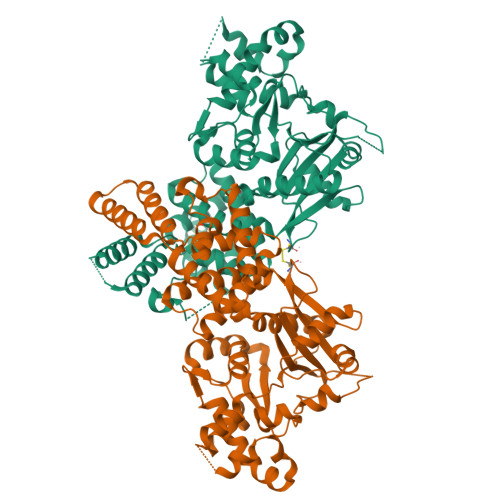Crystal Structures of Malonyl-Coenzyme a Decarboxylase Provide Insights Into its Catalytic Mechanism and Disease-Causing Mutations.
Froese, D.S., Forouhar, F., Tran, T.H., Vollmar, M., Kim, Y.S., Lew, S., Neely, H., Seetharaman, J., Shen, Y., Xiao, R., Acton, T.B., Everett, J.K., Cannone, G., Puranik, S., Savitsky, P., Krojer, T., Pilka, E.S., Kiyani, W., Lee, W.H., Marsden, B.D., von Delft, F., Allerston, C.K., Spagnolo, L., Gileadi, O., Montelione, G.T., Oppermann, U., Yue, W.W., Tong, L.(2013) Structure 21: 1182
- PubMed: 23791943
- DOI: https://doi.org/10.1016/j.str.2013.05.001
- Primary Citation of Related Structures:
2YGW, 4KS9, 4KSA, 4KSF - PubMed Abstract:
Malonyl-coenzyme A decarboxylase (MCD) is found from bacteria to humans, has important roles in regulating fatty acid metabolism and food intake, and is an attractive target for drug discovery. We report here four crystal structures of MCD from human, Rhodopseudomonas palustris, Agrobacterium vitis, and Cupriavidus metallidurans at up to 2.3 Å resolution. The MCD monomer contains an N-terminal helical domain involved in oligomerization and a C-terminal catalytic domain. The four structures exhibit substantial differences in the organization of the helical domains and, consequently, the oligomeric states and intersubunit interfaces. Unexpectedly, the MCD catalytic domain is structurally homologous to those of the GCN5-related N-acetyltransferase superfamily, especially the curacin A polyketide synthase catalytic module, with a conserved His-Ser/Thr dyad important for catalysis. Our structures, along with mutagenesis and kinetic studies, provide a molecular basis for understanding pathogenic mutations and catalysis, as well as a template for structure-based drug design.
Organizational Affiliation:
Structural Genomics Consortium, University of Oxford, Oxford OX3 7DQ, UK.




















